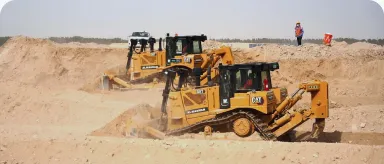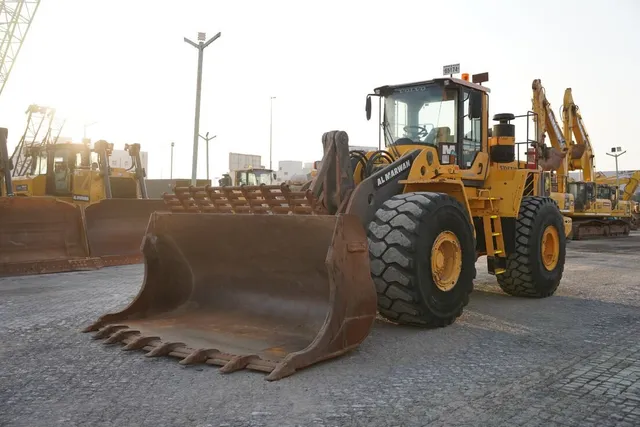Discover the UAE's rapid growth in transportation, housing, and renewable energy driving its global innovation vision
Discover the UAE's rapid growth in transportation, housing, and renewable energy driving its global innovation vision.
The UAE's market is currently experiencing significant growth, with experts forecasting a 4.4% real-term expansion this year and an average annual growth of 3.9% from 2022 to 2025. This growth is supported by the country's unwavering commitment to sustainability, underscored by its pledge to achieve carbon neutrality and its vast investments in renewable energy sources. In this article, we delve into the major construction themes across the UAE, analyzing the impact of these initiatives on different sectors and highlighting the most prominent projects that are shaping the nation's future.
Booming Transportation Industry
The transportation sector is one of the key drivers of the UAE's construction industry, offering substantial opportunities for companies in the construction, engineering, and supply chain sectors. The UAE has identified transportation as critical to its economic diversification and long-term success. One of the most ambitious projects in this area is the Etihad Rail, a USD 13.6 billion high-speed railway initiative. Upon completion, it is expected to transport 36 million passengers and move 60 million tonnes of freight annually by 2030. This project will revolutionize transportation across the country and the region, creating an extensive rail network that links the UAE's major cities and ports.
Etihad Rail is part of a broader strategy to enhance the nation's transportation infrastructure. Complementing this development is the Dubai Metro's Blue Line project. This new metro line will further integrate the city's public transportation system, helping Dubai achieve its goal of becoming a "20-minute city," where all essential services are reachable within 20 minutes. This project not only aligns with the UAE's economic diversification objectives but also supports its innovation and mobility goals. As part of the UAE’s overall vision, these infrastructure developments are expected to spur further economic growth and create more job opportunities in construction and related industries.
The transportation sector's importance goes beyond mobility and convenience; it is central to the UAE's broader vision for innovation and smart cities. Future infrastructure projects in the UAE, such as the proposed Hyperloop, a high-speed transportation system, will likely continue to push the envelope in transportation innovation. The Hyperloop promises to significantly reduce travel time between cities while providing an environmentally sustainable option. These advancements reflect the UAE's long-term vision of positioning itself as a global leader in transportation technology, enhancing not only the nation's connectivity but also its global standing in cutting-edge infrastructure development.
Residential Construction on the Rise
As the UAE’s population continues to grow, the demand for housing has escalated, leading to significant developments in the residential construction sector. One of the major government-backed initiatives addressing this demand is the Sheikh Zayed Housing Programme. This ambitious project aims to construct over 11,000 housing units, ensuring that the housing needs of UAE citizens are met. These homes are designed to offer modern living spaces that cater to the needs of families while also integrating sustainable building practices.
In addition to the Sheikh Zayed Housing Programme, Dubai has outlined a long-term investment of USD 17.7 billion in the Emirati housing program over the next two decades. This investment is expected to drastically improve the quality and availability of housing for UAE nationals, contributing to the overall development of the residential sector. Furthermore, these developments are aligned with the Dubai 2040 Urban Master Plan, which emphasizes creating sustainable, livable communities across the city. Palm Jebel Ali is one such project, showcasing Dubai's vision for the future by integrating environmental considerations with luxury living spaces.
The Dubai 2040 Urban Master Plan is central to the UAE’s focus on improving the quality of life for its residents. This comprehensive plan outlines a vision for the city’s future, balancing urban expansion with sustainability and quality of life improvements. By creating residential areas that are well-connected to transportation networks, parks, and essential services, the UAE is ensuring that its urban development remains both sustainable and forward-thinking. As these residential projects continue to develop, the construction industry will benefit from ongoing demand, creating opportunities for contractors, developers, and suppliers across the sector.
Pioneering Renewable Energy Construction
In line with its carbon neutrality goal, the UAE is investing heavily in renewable energy, with plans to allocate USD 163.4 billion over the next three decades. This investment is part of the nation's long-term strategy to reduce its reliance on fossil fuels and transition to a more sustainable energy model. Central to this effort is the UAE’s Revised Energy Strategy, which aims to triple the share of renewable energy in the country’s energy mix by 2030. This strategy is a clear indication of the UAE's commitment to sustainable development and its desire to be a global leader in the green energy sector.
One of the most remarkable projects contributing to the UAE's renewable energy goals is the Mohammed bin Rashid Al Maktoum Solar Park. This massive solar project is expected to have a production capacity of 5,000 megawatts by 2030, making it one of the largest solar parks in the world. This project is a testament to the UAE's dedication to clean energy and innovation, serving as a model for other nations looking to reduce their carbon footprint. Additionally, the country is exploring other renewable energy sources, including wind and nuclear energy, as part of its holistic approach to achieving sustainability.
The UAE’s efforts are further underscored by the ‘We the UAE 2031’ vision, which aims to generate USD 218 billion in non-oil exports and strengthen the country’s position as a leader in renewable energy. This vision highlights the UAE’s emphasis on sustainability, innovation, and economic diversification, setting it on a path to global leadership in clean energy. New construction projects across the country are increasingly integrating sustainable building practices, such as modular construction, the use of eco-friendly materials, and 3D printing. These methods not only reduce the environmental impact of construction but also enhance efficiency and innovation.
Key projects like the Wynn Resort in Ras Al Khaimah are part of the UAE’s broader focus on sustainability and innovation. This resort, designed with sustainability at its core, reflects the country’s commitment to responsible construction practices. In parallel, the Dubai Economic Agenda D33 has introduced initiatives like 'Sandbox Dubai,' aimed at testing and commercializing new technologies. This initiative is transforming Dubai into a major innovation hub, attracting global attention for its forward-thinking approach to urban development and technology integration.
Market Trends and Vision for the Future
The UAE's economy has demonstrated exceptional resilience, achieving eight consecutive quarters of robust growth. This economic strength is further reinforced by several key initiatives, such as the Dubai 2040 Urban Master Plan and the establishment of the General Commercial Gaming Regulatory Authority (GCGRA). These initiatives exemplify the UAE government's forward-thinking approach, fostering an environment conducive to growth and innovation across multiple sectors, including construction, real estate, and technology.
Dubai’s stock market has seen significant growth, largely driven by the real estate and tourism sectors. The region's stable economic performance continues to attract investors and developers, further contributing to the expansion of the construction industry. The ‘We the UAE 2031’ vision emphasizes four key pillars: creating a forward society, forward economy, forward diplomacy, and forward ecosystem. These pillars represent the UAE's commitment to building a sustainable, innovative, and globally competitive nation.
The Dubai Tourism Strategy and Abu Dhabi Vision 2030 are also playing crucial roles in driving the growth of the construction sector. These strategies focus on enhancing the UAE's appeal as a global destination for business, tourism, and investment. The development of new hotels, resorts, and entertainment facilities, such as the Wynn Resort and the Dubai Harbor, are prime examples of how the UAE is leveraging its construction sector to support its broader economic goals. By creating world-class infrastructure and attractions, the UAE is positioning itself as a leader in global tourism and real estate development.
Global Hub for Growth and Development
The UAE's remarkable economic performance and sustainability focus make it a prime destination for project opportunities across various sectors. The construction industry, in particular, stands to benefit from the UAE’s ongoing investments in transportation, residential housing, and renewable energy. Companies specializing in project management, civil engineering, MEP contracting, and construction supplies have the potential to thrive in this dynamic market.
Moreover, the UAE's dedication to sustainability and innovation is positioning it as a global leader in environmental stewardship and technological advancement. The country’s forward-looking approach to construction, coupled with its ambitious economic and environmental goals, ensures that the UAE will continue to be a hub for growth and development in the Middle East and beyond. As the nation continues to invest in infrastructure, housing, and renewable energy, the construction industry will remain at the forefront of the UAE's economic expansion, contributing to its ongoing success as a global leader in innovation and sustainability.

Read More: https://almarwan.com/news/4429/Al-Layyah-project-heavy-equipment











